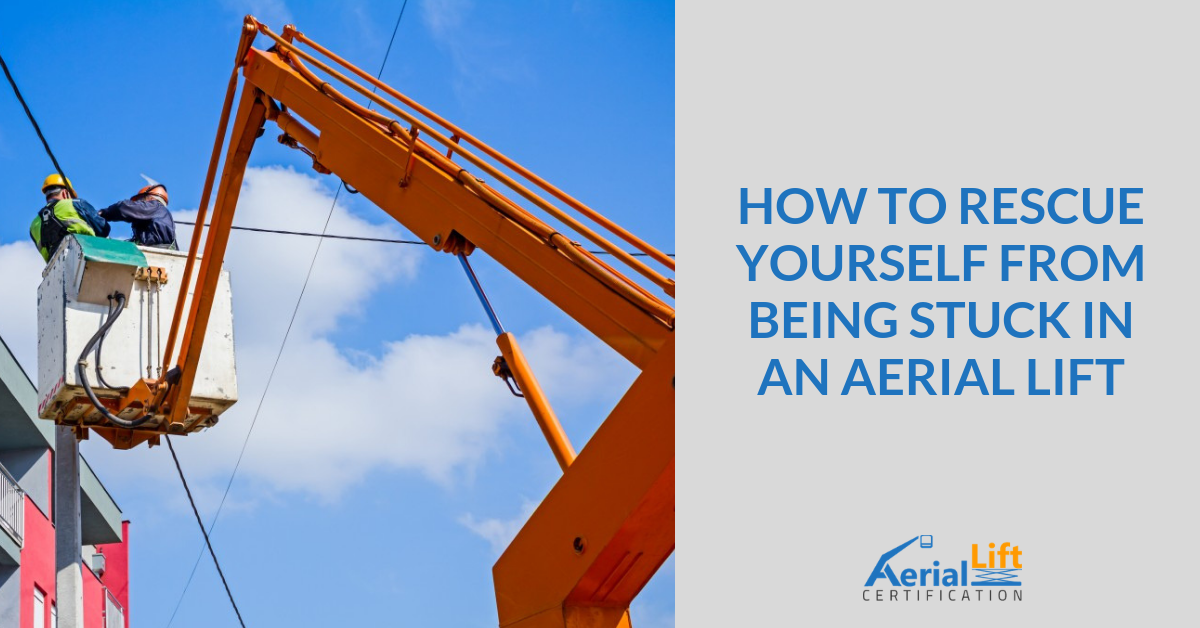Aerial Lift Rescue Best Practices

Actually, this situation is not really “unthinkable.” At least it shouldn’t be. A well-trained aerial lift worker or aerial work platform (AWP) operator should be prepared for anything. This includes any scenario where the lift stops working, resulting in being stranded stories above the ground.
What’s the best way to “rescue” yourself from an immobile aerial lift? The best way is to avoid the situation in the first place.
How can you prevent potential dangers like this? Creating an aerial lift rescue plan is a great place to start. AerialLiftCertification.com offers OSHA-compliant training for this situation and many others – sign up today and get the best aerial lift and scissor lift safety training!



Avoiding an Aerial Lift Rescue
Proper AWP safety includes a whole host of things to do BEFORE you ever get into the bucket. Avoiding an aerial lift rescue means preparing for the worst case scenario. Oftentimes, a worker ends up stuck in a lift because it’s not properly maintained. If your aerial lift is on a regular maintenance schedule, the chances are you’ll never have to worry about this situation.
Bad weather can cause an aerial lift to become stuck. This could happen with mechanical failure (excessive swaying, movement, etc.) or becoming “stuck” against another object (tree, bridge, etc.). Never operate an aerial lift in windy conditions. The chance is simply too great for something bad to happen, and not just a “stuck” aerial lift. Many accidents and injuries on aerial lifts happen in bad weather.
Another common cause of “stuck” aerial lifts involves the terrain. Muddy, wet surfaces basically act as quicksand with a large aerial lift, so make sure your construction site or other outdoor area surfaces can properly support your aerial lift.
Next, you should be aware of surrounding hazards. These include power lines, the ceiling (if you’re working inside, obviously), tree branches and other obstacles. Once you’re stuck, there’s a chance the aerial lift could move, shift, or (worst of all) totally collapse.
But what happens if you’ve taken all the necessary precautions, only to find yourself stuck? There are devices called “self-rescue kits” that, properly used, can safely transport workers to the ground. To use a self-rescue kit, thorough training is a necessity. Make this training a part of your organization’s aerial lift rescue plan.
Common Reasons for an Aerial Lift Rescue
By understanding the most common reasons for an aerial lift rescue, you can mentally prepare to avoid such situations. Running out of fuel is perhaps the most common reason for getting stuck. A pre-start inspection of your equipment can help you avoid this issue. Before getting in the lift, conduct a thorough review of all the parts of the lift, including the fuel tank. Whether your lift requires a charged battery or diesel, fueling up before getting started can help you avoid being stranded.
Overloading is another common reason why aerial lifts get stuck. Many lifts have load-sensing capabilities. Should the platform become overloaded or be pushed against a structure, the lift may shutdown automatically. That’s why it’s so important to read the operator’s manual before getting started. Review the manual, practice using the lift, and be patient – this can help you avoid employing your aerial lift rescue plan.
Creating an Aerial Lift Rescue Plan


If you find your worker in an unfortunate situation of being stuck in a lift, you need a plan on how to handle things until you have a resolution. That’s equally true if your scissor lift won’t go up all the way. When you have a plan for a boom lift stuck in the air or any other kind of lift that stopped operating with a worker on it, everyone will feel less panicked. Here are some tips:
✓ Assess the Situation
While you might be tempted to rush in and attempt an aerial lift rescue at the first sign of trouble, it’s often best to take a moment to fully understand the task at hand. Take a step back to be sure a rescue attempt is wise. If power lines are nearby, you will need to wait for emergency help. Have workers know to call a supervisor with an assessment of the situation.
✓ Consider How to Lower the Lift
Brainstorm ideas for lowering the lift. Telescoping is usually the first option before lowering to the ground.
✓ Use a Rollout Deck to Avoid Collisions
The deck on a scissor lift should be rolled to avoid a collision with nearby obstacles on the descent.
✓ Involve the Operator in Aerial Lift Rescue Plan
A conscious, coherent, and calm operator can typically participate in a well thought out aerial lift rescue plan. If they are panicked or unconscious, an assisted rescue is necessary.
Sometimes even with the best preparation, unfortunate situations like being stuck in an aerial lift can’t be avoided. With the proper training, your workers can deal with it and prevent injury.



Make Training Part of Your Aerial Lift Rescue Plan
Avoiding aerial lift rescues often boils down to proper preparation. When your company has the proper training in place (and every company should), things such as being stuck in aerial lifts, are much less common. From a regular maintenance plan to well-trained employees, it simply makes sense to get the best aerial lift and scissor lift training possible.
And speaking of training, Aerial Lift Certification offers superior aerial lift and aerial work platform safety courses. We cover all the basics, including some advanced concepts as well. Our course is simply the most complete, affordable, hassle-free aerial lift training program available today.
We have 3 different courses, each with targeted learning concepts. Whether you need to Train the Trainer, Training Kit or Bundle Package, we have what you’re looking for. Check out the AerialLiftCertification.com contact page or call our aerial lift OSHA safety experts at (888) 278-8896.